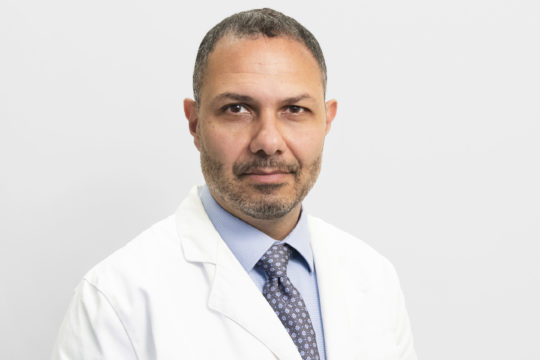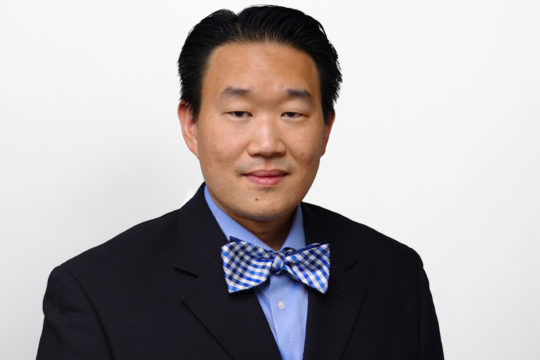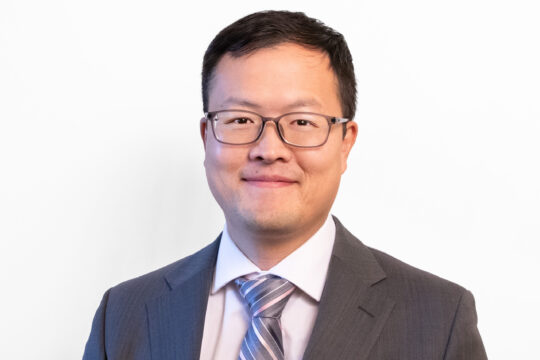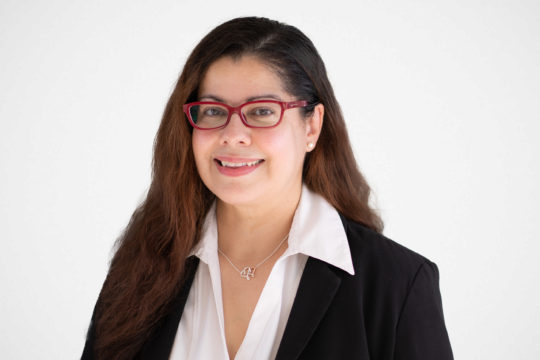Research in the Department of Neurosurgery
The Lifespan and Brown University Department of Neurosurgery is actively engaged in translational science and clinical research spanning the breadth of neurological disease. Major areas of interest include cancers of the brain and spine, cerebrospinal fluid disorders, brain and spine trauma, pain, epilepsy, spinal neuroprosthetics, and neuromodulation for movement, cognitive and psychiatric disorders. Our team of neurosurgeon scientists, clinical researchers, and senior research faculty push the boundaries of current knowledge to attain better patient outcomes and create new therapies.
Our faculty collaborate with clinicians and scientists in other hospital departments, including Neurology, Psychiatry, Pathology & Laboratory Medicine, Neuro-Oncology, Neurocritical Care, Interventional Radiology, and Emergency Medicine. In addition, our faculty participate in a wide variety of ongoing collaborations with the Brown University Carney Institute for Neuroscience and affiliated groups such as Neuroscience, Neuro-Engineering and Cognitive, Linguistic and Psychological Science.
Recent Research Publications
Seizure and anatomical outcomes of repeat laser amygdalohippocampotomy for temporal lobe epilepsy: A single-institution case series. Zheng B, Abdulrazeq H, Shao B, Liu DD, Leary O, Lauro PM, Bartolini L, Blum AS, Asaad WF. Epilepsy Behav. 2023 Jul 28;146:109365. doi:10.1016/j.yebeh.2023.109365. Epub ahead of print. PMID:37523797.
 For patients with difficult-to-treat seizures in a specific type of epilepsy (temporal lobe epilepsy), a minimally invasive procedure called laser interstitial thermotherapy (LITT) is sometimes used. However, one LITT treatment may not always completely stop seizures. This study looked at patients who had two LITT procedures to see if the second one could improve seizure control. They found that targeting even small remaining problematic areas with a second LITT procedure led to better seizure control in all patients studied. This suggests that repeating this procedure might be a valuable option for patients with persistent seizures, sparing them from more invasive surgeries or less effective treatments. Further research is needed to confirm these findings with a larger group of patients.
For patients with difficult-to-treat seizures in a specific type of epilepsy (temporal lobe epilepsy), a minimally invasive procedure called laser interstitial thermotherapy (LITT) is sometimes used. However, one LITT treatment may not always completely stop seizures. This study looked at patients who had two LITT procedures to see if the second one could improve seizure control. They found that targeting even small remaining problematic areas with a second LITT procedure led to better seizure control in all patients studied. This suggests that repeating this procedure might be a valuable option for patients with persistent seizures, sparing them from more invasive surgeries or less effective treatments. Further research is needed to confirm these findings with a larger group of patients.
Postnatal Myelomeningocele Repair in the United States: Rates and Disparities Before and After the Management of Myelomeningocele Study Trial. Shao B, Chen JS, Kozel OA, Tang OY, Amaral-Nieves N, Sastry RA, Watson-Smith D, Monteagudo J, Luks FI, Carr SR, Klinge PM, Weil RJ, Svokos KA. Neurosurgery. 2023 Jul 21. doi: 10.1227/neu.0000000000002604. Epub ahead of print. PMID: 37477441.
 Advances in medical techniques have changed the way we treat myelomeningocele, a birth defect affecting the spine. A study looked at how often surgery was done after birth (postnatal MMCr) before and after a major trial in 2011. The study found that after 2011, fewer surgeries were done this way. Most surgeries after the trial were for patients with Medicaid and lower incomes. However, differences in care based on race/ethnicity were getting better. This highlights the need to improve care for all myelomeningocele patients, both before and after they’re born.
Advances in medical techniques have changed the way we treat myelomeningocele, a birth defect affecting the spine. A study looked at how often surgery was done after birth (postnatal MMCr) before and after a major trial in 2011. The study found that after 2011, fewer surgeries were done this way. Most surgeries after the trial were for patients with Medicaid and lower incomes. However, differences in care based on race/ethnicity were getting better. This highlights the need to improve care for all myelomeningocele patients, both before and after they’re born.
Performance of ChatGPT, GPT-4, and Google Bard on a Neurosurgery Oral Boards Preparation Question Bank. Ali R, Tang OY, Connolly ID, Fridley JS, Shin JH, Zadnik Sullivan PL, Cielo D, Oyelese AA, Doberstein CE, Telfeian AE, Gokaslan ZL, Asaad WF. Neurosurgery. 2023 Jun 12. doi:10.1227/neu.0000000000002551. Epub ahead of print. PMID: 37306460.
 Large language models (LLMs) like GPT-3.5, GPT-4, and Google Bard were tested on a neurosurgery exam with complex questions. GPT-4 showed the highest accuracy, getting 82.6% of questions right, while GPT-3.5 scored 62.4%, and Bard got 44.2% correct. GPT-4 excelled in various categories, especially spine-related questions. Questions that required higher-order problem solving were harder for GPT-3.5 and Bard, but not for GPT-4. GPT-4 performed well on imaging questions, even outperforming GPT-3.5 and Bard, and had fewer instances of incorrect “hallucination” in responses. This study highlights GPT-4’s effectiveness in answering complex neurosurgery questions and its potential for medical applications.
Large language models (LLMs) like GPT-3.5, GPT-4, and Google Bard were tested on a neurosurgery exam with complex questions. GPT-4 showed the highest accuracy, getting 82.6% of questions right, while GPT-3.5 scored 62.4%, and Bard got 44.2% correct. GPT-4 excelled in various categories, especially spine-related questions. Questions that required higher-order problem solving were harder for GPT-3.5 and Bard, but not for GPT-4. GPT-4 performed well on imaging questions, even outperforming GPT-3.5 and Bard, and had fewer instances of incorrect “hallucination” in responses. This study highlights GPT-4’s effectiveness in answering complex neurosurgery questions and its potential for medical applications.
Concurrent decoding of distinct neurophysiological fingerprints of tremor and bradykinesia in Parkinson’s disease. Lauro PM, Lee S, Amaya DE, Liu DD, Akbar U, Asaad WF. Elife. 2023 May 30;12:e84135. doi: 10.7554/eLife.84135. PMID: 37249217; PMCID: PMC10264071.
![]() Parkinson’s disease (PD) has varying motor symptoms like tremor and bradykinesia. Researchers studied brain activity in PD patients during motor tasks to decode these symptoms and periods of better movement control. They used microelectrode and electrocorticography recordings and found that tremor and bradykinesia have different brain patterns, and effective motor control has unique features. Cortical decoding was more effective than subcortical, and within the subthalamic nucleus, different subregions decoded tremor and bradykinesia. This research could lead to better treatment strategies for PD by using neurophysiological insights.
Parkinson’s disease (PD) has varying motor symptoms like tremor and bradykinesia. Researchers studied brain activity in PD patients during motor tasks to decode these symptoms and periods of better movement control. They used microelectrode and electrocorticography recordings and found that tremor and bradykinesia have different brain patterns, and effective motor control has unique features. Cortical decoding was more effective than subcortical, and within the subthalamic nucleus, different subregions decoded tremor and bradykinesia. This research could lead to better treatment strategies for PD by using neurophysiological insights.
Cerebrospinal fluid transcripts may predict shunt surgery responses in normal pressure hydrocephalus. Levin Z, Leary OP, Mora V, Kant S, Brown S, Svokos K, Akbar U, Serre T, Klinge P, Fleischmann A, Ruocco MG. Brain. 2023 May 19:awad109. doi: 10.1093/brain/awad109. Epub ahead of print. PMID: 37208310.
 Normal pressure hydrocephalus (NPH) is a neurodegenerative disorder that can be treated with a ventricular shunt, improving symptoms. Researchers studied the RNA in extracellular vesicles from 42 NPH patients’ cerebrospinal fluid (CSF) to find genes and pathways linked to symptom improvement after shunt surgery. They developed a machine learning algorithm using these gene profiles to predict surgery response accurately. This discovery could enhance NPH diagnosis, treatment, and understanding of the disease’s causes.
Normal pressure hydrocephalus (NPH) is a neurodegenerative disorder that can be treated with a ventricular shunt, improving symptoms. Researchers studied the RNA in extracellular vesicles from 42 NPH patients’ cerebrospinal fluid (CSF) to find genes and pathways linked to symptom improvement after shunt surgery. They developed a machine learning algorithm using these gene profiles to predict surgery response accurately. This discovery could enhance NPH diagnosis, treatment, and understanding of the disease’s causes.
Gamma knife capsulotomy for intractable OCD: Neuroimage analysis of lesion size, location, and clinical response. McLaughlin NCR, Magnotti JF, Banks GP, Nanda P, Hoexter MQ, Lopes AC, Batistuzzo MC, Asaad WF, Stewart C, Paulo D, Noren G, Greenberg BD, Malloy P, Salloway S, Correia S, Pathak Y, Sheehan J, Marsland R, Gorgulho A, De Salles A, Miguel EC, Rasmussen SA, Sheth SA. Transl Psychiatry. 2023 Apr 26;13(1):134. doi: 10.1038/s41398-023-02425-2. PMID: 37185805; PMCID: PMC10130137.
![]() Obsessive-compulsive disorder (OCD) affects a significant portion of the population, and some patients don’t respond well to conventional treatments. Gamma knife capsulotomy (GKC) is an option for such cases. Researchers studied patients who received GKC targeting a brain region. They found that lesions in specific locations within this region were associated with the most significant reduction in OCD symptoms. Lesions toward the back and top of this area were particularly effective. The study indicates GKC remains effective for refractory OCD, and targeting specific regions might optimize treatment outcomes. Further research is needed to better understand individual variations and refine targeting methods.
Obsessive-compulsive disorder (OCD) affects a significant portion of the population, and some patients don’t respond well to conventional treatments. Gamma knife capsulotomy (GKC) is an option for such cases. Researchers studied patients who received GKC targeting a brain region. They found that lesions in specific locations within this region were associated with the most significant reduction in OCD symptoms. Lesions toward the back and top of this area were particularly effective. The study indicates GKC remains effective for refractory OCD, and targeting specific regions might optimize treatment outcomes. Further research is needed to better understand individual variations and refine targeting methods.
Microsurgical approach for resection of the filum terminale internum in tethered cord syndrome-a case demonstration of technical nuances and vignettes. Abdulrazeq H, Shao B, Sastry RA, Klinge PM. Acta Neurochir (Wien). 2023 Apr 5. doi: 10.1007/s00701-023-05568-9. Epub ahead of print. PMID: 37017726.
![]() A new surgical technique is proposed for tethered cord syndrome caused by filum terminale issues. Instead of the traditional approach, this method involves microsurgery at a higher level to remove the distal part of the filum terminale through a limited interlaminar approach. This aims to effectively release the cord from intradural attachments, minimizing leftover remnants.
A new surgical technique is proposed for tethered cord syndrome caused by filum terminale issues. Instead of the traditional approach, this method involves microsurgery at a higher level to remove the distal part of the filum terminale through a limited interlaminar approach. This aims to effectively release the cord from intradural attachments, minimizing leftover remnants.
Influence of socioeconomic factors on discharge disposition following traumatic cervicothoracic spinal cord injury at level I and II trauma centers in the United States. Hagan MJ, Pertsch NJ, Leary OP, Ganga A, Sastry R, Xi K, Zheng B, Behar M, Camara-Quintana JQ, Niu T, Sullivan PZ, Abinader JF, Telfeian AE, Gokaslan ZL, Oyelese AA, Fridley JS. N Am Spine Soc J. 2022 Nov 25;12:100186.doi:10.1016/j.xnsj.2022.100186. PMID: 36479003; PMCID:PMC9720595.
 After spinal cord injury (SCI), the type of post-discharge rehabilitation used can affect recovery. Researchers analyzed data from 2012-2016 and found that factors like age, gender, insurance (Medicare), psychiatric diagnosis, injury severity, and Glasgow Coma Score influenced the likelihood of being discharged to non-home facilities. Interestingly, uninsured patients were less likely to use additional healthcare facilities for recovery after surgical SCI treatment, possibly due to high costs. This suggests that economic barriers can impact the choice of rehabilitation services for SCI patients.
After spinal cord injury (SCI), the type of post-discharge rehabilitation used can affect recovery. Researchers analyzed data from 2012-2016 and found that factors like age, gender, insurance (Medicare), psychiatric diagnosis, injury severity, and Glasgow Coma Score influenced the likelihood of being discharged to non-home facilities. Interestingly, uninsured patients were less likely to use additional healthcare facilities for recovery after surgical SCI treatment, possibly due to high costs. This suggests that economic barriers can impact the choice of rehabilitation services for SCI patients.
Long-Term Motor versus Sensory Lumbar Plexopathy After Lateral Lumbar Interbody Fusion: Single-Center Experience, Intraoperative Neuromonitoring Results, and Multivariate Analysis of Patient-Level Predictors. Zheng B, Leary OP, Beer RA 2nd, Liu DD, Nuss S, Barrios-Anderson A, Darveau S, Syed S, Gokaslan ZL, Telfeian AE, Oyelese AA, Fridley JS. World Neurosurg. 2023 Feb;170:e568-e576. doi:10.1016/j.wneu.2022.11.071. Epub 2022 Nov 24. PMID: 36435383.
 Lateral lumbar interbody fusion (LLIF) is a surgery for spinal fusion, but it can lead to plexopathies (nerve issues). A study on 127 patients who underwent LLIF found that around 37.8% developed sensory or motor plexopathies. Most cases (64.6%) resolved within about 402 days. Ipsilateral plexopathies (on the same side as the surgery) were more common. Persistent symptoms were linked to the number of fused levels and surgical duration. Unresolved neuromonitoring alerts during surgery increased the risk of developing plexopathies. This research highlights the common occurrence of plexopathies after LLIF and factors affecting their persistence.
Lateral lumbar interbody fusion (LLIF) is a surgery for spinal fusion, but it can lead to plexopathies (nerve issues). A study on 127 patients who underwent LLIF found that around 37.8% developed sensory or motor plexopathies. Most cases (64.6%) resolved within about 402 days. Ipsilateral plexopathies (on the same side as the surgery) were more common. Persistent symptoms were linked to the number of fused levels and surgical duration. Unresolved neuromonitoring alerts during surgery increased the risk of developing plexopathies. This research highlights the common occurrence of plexopathies after LLIF and factors affecting their persistence.
Not Just an Anchor: The Human Filum Terminale Contains Stretch Sensitive and Nociceptive Nerve Endings and Responds to Electrical Stimulation With Paraspinal Muscle Activation. Klinge PM, McElroy A, Leary OP, Donahue JE, Mumford A, Brinker T, Gokaslan ZL. Neurosurgery. 2022 Oct 1;91(4):618-624. doi:10.1227/neu.0000000000002081. Epub 2022 Jul 21. PMID: 35852974; PMCID: PMC9447435.
 The fibrous filum terminale (FT), previously thought to be non-functional, was studied in patients undergoing surgery for tethered cord syndrome. Microscopy revealed sensory nerve endings within the FT’s core resembling mechanoreceptors and pain receptors found in skin and muscles. Electrical stimulation of the FT triggered muscle activity above and below the stimulated area. This suggests that the FT has functional sensory nerves, potentially serving as a proprioceptive element and contributing to back pain in spinal disorders.
The fibrous filum terminale (FT), previously thought to be non-functional, was studied in patients undergoing surgery for tethered cord syndrome. Microscopy revealed sensory nerve endings within the FT’s core resembling mechanoreceptors and pain receptors found in skin and muscles. Electrical stimulation of the FT triggered muscle activity above and below the stimulated area. This suggests that the FT has functional sensory nerves, potentially serving as a proprioceptive element and contributing to back pain in spinal disorders.
Electric-field facilitated rapid and efficient dissociation of tissues Into viable single cells. Welch EC, Yu H, Barabino G, Tapinos N, Tripathi A. Sci Rep. 2022 Jun 24;12(1):10728. doi:10.1038/s41598-022-13068-6. PMID: 35750779; PMCID: PMC9232619.
 Single-cell analysis is a growing field that examines genetic profiles of individual cells. This research presents a novel method to break down complex tissues into individual cells for analysis. By placing a tissue biopsy core in a cavity filled with liquid and applying an electric field between electrodes, rapid tissue dissociation occurs. Experimenting with different conditions and simulations, the technique dissociated tissue sections up to 95% in just 5 minutes, preserving cell viability and morphology. This approach could be valuable for preparing tissue samples for direct single-cell analysis, improving efficiency and accuracy.
Single-cell analysis is a growing field that examines genetic profiles of individual cells. This research presents a novel method to break down complex tissues into individual cells for analysis. By placing a tissue biopsy core in a cavity filled with liquid and applying an electric field between electrodes, rapid tissue dissociation occurs. Experimenting with different conditions and simulations, the technique dissociated tissue sections up to 95% in just 5 minutes, preserving cell viability and morphology. This approach could be valuable for preparing tissue samples for direct single-cell analysis, improving efficiency and accuracy.
Research Statistics

Research Faculty
Research Staff and Contact Info
Address Mail To:
Owen Leary
Rhode Island Hospital
APC Building, Floor 6
593 Eddy St, Providence RI 02903
Phone: (401) 793-9166; (401) 606-8388
Fax: (401) 606-4011

















